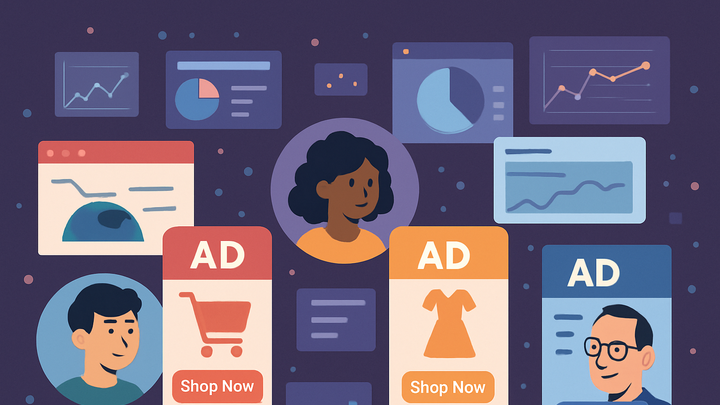Published on 2025-06-26T05:20:30Z
What is Ad Personalization? Definition, Examples, and Best Practices
Ad Personalization refers to customizing advertising content and delivery to individual users or user segments based on collected data such as browsing behavior, demographics, interests, and real-time context. Within analytics, it leverages insights from platforms like Google Analytics 4 (GA4) and cookie-free solutions like PlainSignal to inform audience segmentation, optimize creative assets, and trigger dynamic ad experiences. By analyzing first-party data, tracking user interactions via script integrations, and combining it with advanced audience modeling, marketers can deliver highly relevant ads that improve click-through rates, engagement, and conversion performance. Implementing ad personalization involves setting up robust data collection frameworks, defining precise audience segments, and integrating analytics outputs with ad platforms or personalization engines. Best practices include maintaining strict compliance with privacy regulations (e.g., GDPR, CCPA), continuously testing creative variations, and ensuring the quality and recency of data. When executed properly, ad personalization boosts ROI while fostering a more user-centric advertising experience.
Ad personalization
Tailoring ads to individual users using analytics data to improve relevance, engagement, and ROI.
Why Ad Personalization Matters
Ad personalization plays a critical role in modern digital marketing by delivering more relevant content, fostering user engagement, and increasing conversions. This section explores its core benefits and impact on business metrics.
-
Improved relevance
Personalized ads speak directly to user preferences and behaviors, increasing the likelihood of capturing attention.
-
Enhanced engagement
Users are more likely to interact with ads that reflect their interests, leading to higher click-through rates.
-
Increased conversion rates
Targeted messaging and offers can boost conversions by addressing individual needs and pain points.
-
Better roi
Allocating ad spend towards the most receptive audiences maximizes return on investment.
Core Components of Ad Personalization
Effective ad personalization depends on several foundational elements, from data collection to dynamic creative delivery. Understanding these components is essential for building a robust personalized advertising strategy.
-
User data collection
Gathering first-party and third-party data to build comprehensive user profiles.
-
First-party data
Information collected directly from user interactions on owned properties.
-
Second-party data
Data shared between trusted partners.
-
Third-party data
Data purchased from external sources to enrich targeting.
-
-
Audience segmentation
Dividing users into groups based on characteristics, behaviors, and interests.
-
Demographic segments
Groups based on age, gender, location, and other demographic factors.
-
Behavioral segments
Groups defined by past actions like site visits or purchases.
-
Contextual segments
Grouping based on context like time of day or device type.
-
-
Dynamic creative optimization
Automatically generating and rotating ad creatives tailored to each segment.
-
Creative elements
Visuals, headlines, and calls-to-action that can be personalized.
-
Real-time personalization
Using live data to adjust creative content on the fly.
-
-
Ad delivery channels
Platforms and mediums used to serve personalized ads.
-
Display advertising
Banner and display ads on websites and apps.
-
Social media
Personalized ads on platforms like Facebook, Instagram, and LinkedIn.
-
Email marketing
Targeted email campaigns based on user segments.
-
Implementing Ad Personalization with Analytics Tools
Leveraging analytics platforms like GA4 and PlainSignal is key to driving data-informed personalization. This section outlines practical steps and code integration examples to get started.
-
Google analytics 4 (GA4)
Use GA4 to define custom dimensions, create audiences, and trigger personalization events in ad platforms.
-
Configure custom dimensions
Set up additional user and event properties for detailed segmentation.
-
Define audiences
Build audiences based on behavior, demographics, and conversion events.
-
Activate audiences
Export GA4 audiences to Google Ads for targeted campaign delivery.
-
-
PlainSignal (cookie-free analytics)
Integrate PlainSignal’s lightweight tracking script for privacy-focused data collection without cookies:
<link rel="preconnect" href="//eu.plainsignal.com/" crossorigin /> <script defer data-do="yourwebsitedomain.com" data-id="0GQV1xmtzQQ" data-api="//eu.plainsignal.com" src="//cdn.plainsignal.com/plainsignal-min.js"></script>-
Install tracking code
Embed the PlainSignal snippet in your site header.
-
Create custom segments
Use PlainSignal’s dashboard to define audience segments based on events.
-
Export data
Connect with ad platforms or your personalization engine via API.
-
-
Integrations and apis
Connect your analytics data to ad servers and personalization engines using APIs.
-
Google ads api
Programmatically manage campaigns and audiences.
-
Dsp integrations
Use demand-side platform APIs for real-time bidding.
-
Cdp connections
Sync customer data from analytics to your Customer Data Platform.
-
Best Practices and Common Pitfalls
Ensure effective and compliant personalization by following best practices and avoiding common mistakes that can undermine user trust or campaign performance.
-
Privacy and compliance
Respect user privacy laws and implement consent management.
-
Obtain user consent
Use clear opt-in mechanisms for data collection.
-
Data minimization
Collect only the data you need for personalization.
-
Regular audits
Review data practices to ensure ongoing compliance.
-
-
Testing and optimization
Continuously test creative variations and audience segments to find the most effective combinations.
-
A/b testing
Compare two variants to determine the best performer.
-
Multivariate testing
Test multiple elements simultaneously for deeper insights.
-
Iterative improvements
Use test results to refine personalization strategies.
-
-
Avoiding overpersonalization
Strike a balance between relevance and privacy to prevent user fatigue or discomfort.
-
Respect frequency caps
Limit the number of times a user sees the same personalized ad.
-
Contextual sensitivity
Avoid using sensitive personal data that may feel intrusive.
-
-
Ensuring data quality
Maintain accurate, clean, and up-to-date data to power meaningful personalization.
-
Data validation
Implement checks to catch anomalies or errors.
-
Regular updates
Refresh datasets to reflect current user behaviors.
-
Monitor data sources
Track the reliability of each data feed you use.
-
